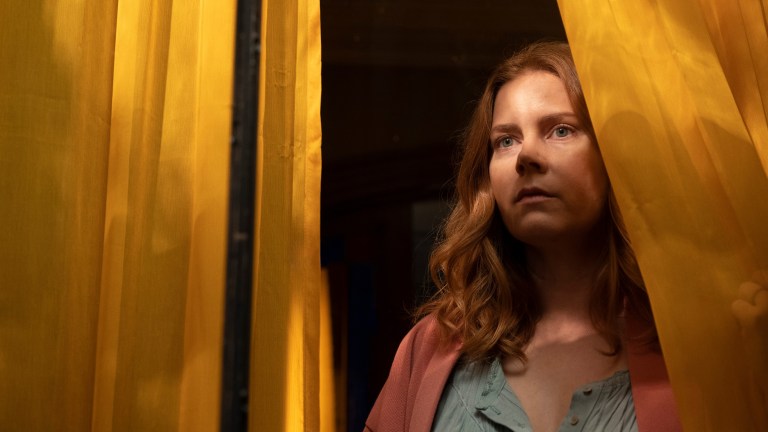The Woman in the Window: Why ‘Grip Lit’ Has Found Its Natural Home on TV
Netflix film The Woman in the Window might not have been well received by critics, but female-centric crime-thriller shows are booming on the small screen.

In The Woman in the Window, Amy Adams plays an agoraphobic woman who thinks she’s witnessed the murder of her female neighbor. But when the police investigate, the neighbor is alive and well. She’s also a completely different woman… Based on the best selling novel by A. J. Finn, which garnered positive reviews on its 2018 release, Joe Wright’s screen adaptation has not proven as much of a hit with critics.
Various complaints have been leveled against the movie, which owes more than a small debt to Alfred Hitchcock – not an easy comparison to weather – including that the characters are hard to care for and the plot comes so thick and fast as to be beyond implausible. While in many ways, it is pointless criticizing a film for what it’s not, recent trends on the small screen suggest that this story would’ve just been better as telly.
Grip lit, a term apparently coined by best selling novelist Marian Keyes, is a subgenre of crime fiction that became extremely popular in the 2010s. The phrase refers to literature so gripping you can’t bear to put it down, and tends to be high concept crime stories featuring a female protagonist (who is not a cop), who has to unravel a mystery, often in a domestic setting. Books like Gone Girl, Before I Go To Sleep, and The Girl on the Train (all made into movies with big stars) were cornerstones of the genre.
While anecdotally, within the publishing industry, the wild hunger for grip lit might have died down, in the world of TV it’s never been bigger. Big ticket TV based on grip lit books is everywhere, from Big Little Lies and Little Fires Everywhere to The Undoing, Sharp Objects, and Behind Her Eyes, and the subgenre isn’t going anywhere soon.
Nine Perfect Strangers, which is set to star Nicole Kidman and Melissa McCarthy, is coming to Amazon as an eight-part series later this year. It’s based on a novel by Liane Moriarty who wrote the Big Little Lies novel, and the new show is executive produced by David E. Kelley, who made Big Little Lies and The Undoing, as well as shows like Ally McBeal and L.A. Law.
These productions have big, meaty roles for women and are often backed by their stars – Nicole Kidman’s Blossom Films co-produced The Undoing, Big Little Lies, and Nine Perfect Strangers; Reese Witherspoon’s company, Hello Sunshine, also co-produced Big Little Lies.
These shows are glossy, starry, and distinctive and feature plotlines related to relationships, to parenting, to abuse, to mental health issues, to wealth, class, and race as well as female friendship and rivalry. They also often feature murder, and in the case of Big Little Lies and The Undoing at least, it’s murder within a particular affluent and influential group in an idyllic setting. What’s more, these shows regularly garner awards.
TV is leaps and bounds ahead of movies when it comes to featuring female talent in front of and behind the camera, and audiences love it.
And properties which aren’t based on best selling novels are using the grip lit mold to great success too. Netflix original Dead to Me, starring Christina Applegate and Linda Cardellini (who are both on board as producers) has a classic grip lit format, for example.
It stands to reason that TV would be a natural home for these stories. A page-turner so compelling you can’t put it down is surely the equivalent to a series so addictive you can’t turn it off. It’s not exactly an achievement to have a 90-minute movie, “so compulsive that you don’t bin it off half way!”
Grip lit’s bread and butter is cliffhangers. The structure of TV shows means you can really lean into this, throwing a curveball at the close of an episode, and then starting the next installment with something completely different, meaning the viewer has to wait to find out what was going on with that amazing revelation. And by the time you do, you’ve often been wrong-footed once again.
Grip lit on TV also gives you the space to really get to know the characters. Though there is a murder at the center of Big Little Lies, for example, this is a character piece and a portrait of a town as much as a thriller. So when we finally learn what happened, it is earned, and we have loved spending time with these women along the way.
Perhaps had The Woman in the Window been a series, we would have had space to get to know Adams’ Anna character enough to really start to wonder whether she is indeed hallucinating. Perhaps Gary Oldman as Alistair could have had some terrifying standout moments like the truly wonderful Donald Sutherland did in The Undoing. And maybe we’d have got to know Jennifer Jason Leigh’s character more than not at all.
Grip lit isn’t new. And it isn’t at all true that it can’t work as a film. Daphne du Maurier is perhaps the godmother of grip lit, and Hitchcock made some fine grip lit movies, including, of course, Rebecca, based on du Maurier’s novel.
But if the taste for this kind of work is waning in the literary world, it’s booming on the small screen, putting complex women front and center and keeping us on the edge of our seats the whole way through. Now all we need is for someone to invent a catchy name for it.
The Woman in the Window is streaming on Netflix now.
